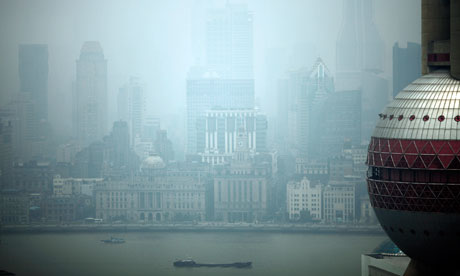Beijing is not the only Asian city with lethal air pollution
The Chinese capital is just one of hundreds of cities where poisonous air is the fastest growing cause of death

A view of the Oriental Pearl TV tower and downtown Shanghai. A report in the Lancet says that worldwide, a record 3.2 million people died from air pollution in 2010, compared with 800,000 in 2000. Photograph: Carlos Barria/Reuters
Air pollution in Beijing has been described as "apocalyptic" this week with people choking their way through murky streets, short of breath and their eyes stinging from toxic air. But Beijing is just one of hundreds of cities, largely in Asia, where poisonous air is now the fastest growing cause of death in urban populations.
In the past few months there have been acute air pollution incidents reported in Bangladesh, Iran, Afghanistan, Nepal, and Pakistan. In Tehran, the desperate authorities had to close all public offices, schools, universities and banks twice in the last two months; In Nepal the army has had to give up its cars and in Kabul it has been reported that there are now more deaths as a result of air and water pollution than from conflict.
Statistics are unreliable, with few cities able to monitor accurately either the source or the level of the cocktail of pollutants emitted by traffic, ships, industry, brick kilns and domestic heating. But go to the hospitals and doctors will tell you that up to 80% of people admitted come with respiratory or other chronic diseases linked to air pollution. In Tehran, more than 4,500 people were said to have died last year because of air pollution – but because cancers can take years to develop the true figure may be far higher.
Perhaps because there are no drugs available to counter air pollution, it has never been taken as seriously by governments as other diseases like HIV/Aids or malaria, even though the World Health Organisation estimates more than 2 million people worldwide die every year from bad air and that it is now among the top 10 killers in the world. But governments may have to act as new research shows it to be rapidly worsening.
The biggest study done so far, published one month ago in the Lancetsuggested that, worldwide, a record 3.2 million people died from air pollution in 2010, compared with 800,000 in 2000. The annual Global Burden of Disease (GBD) report ranked air pollution for the first time in the world's top 10 list of killer diseases, with 1.2 million deaths a year in east Asia and China, and 712,000 in south Asia, including India.
But while Beijing got the headlines this week, there is mounting evidence that air pollution in India is as bad, if not worse, than in China. A study conducted by satellite imagery by Tel Aviv University last year reported that Indian megacities were seeing double digit increases in air pollution. From 2002 to 2010, said the paper, Bangalore saw the second highest increase in air-pollution levels in the world at 34%,with Pune, Mumbai, Nagpur and Ahmedabad not far behind. Improvements in car and fuel technology have been made since 2000 but these are nullified by the sheer increase in car numbers. Nearly 18m cars are expected to be sold this year alone in India.
The blame is variously levelled on the geography of cities, the inversion of temperatures especially in cold months which trap pollutants, the vastly increasing number of cars, power plants, forest fires and the boom in building construction. However, the Lancet study found that it was specifically the type of air pollution caused by car and truck exhaust that was doing the most health damage.
There is increasing evidence too that the air pollution now plaguing cities is because the fuel being burned by millions of cars and motorbikes is heavily contaminated by dealers who mix petrol and diesel with kerosene, waste industrial solvents and other additives to produce cheaper fuel. The result is a cocktail of poisonous emissions, many of which are not picked up by government monitoring stations and which are not filtered out by catalytic converters.
The scale of illegal fuel adulteration is unknown, but academic studies suggest it is rampant in poor countries like Nepal, Pakistan and Afghanistan, all of which depend on importing fuel from outside. Onestudy in Nepal found that at least half the motorbikes in use had engines damaged by contaminated fuel.
But rich countries should not think their air is clean. A report by the European environment agency found that almost one third of Europe's city dwellers are exposed to PM10 particulate concentrations above EU legal limits and 90-95% to concentrations of smaller and even more deadly PM2.5 particulates. If nothing is done to improve it, the EU expects to see 200,000 premature deaths a year in Europe by 2020 due to particle emissions alone.
EU environment commissioner Janez Potočnik spelled out the financial costs on the European economy in September: "Clean air is an investment. We cannot afford not to act. In monetary terms … the associated costs [will] amount to between €189-609bn per year in 2020. Our current analysis shows that if we do nothing, we will see 200,000 premature deaths in the EU by 2020 due to particle emissions alone - but with concerted action, this number can be pushed down to 130,000. To invest in clean air means to invest in our future."
No hay comentarios:
Publicar un comentario